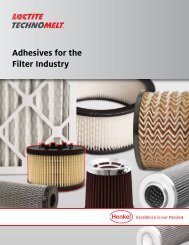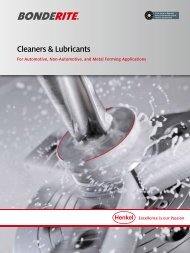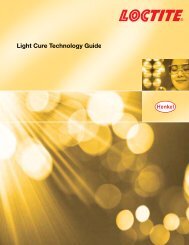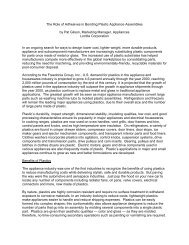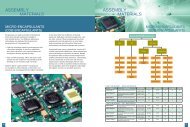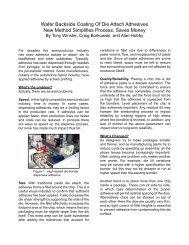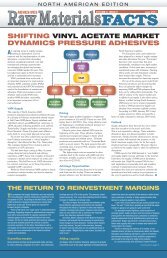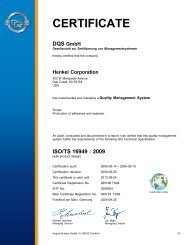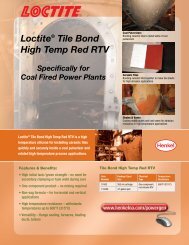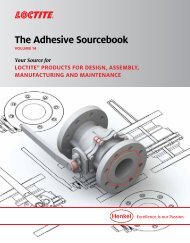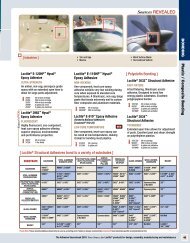Hysol® Surface Preparation Guide
Hysol® Surface Preparation Guide
Hysol® Surface Preparation Guide
Create successful ePaper yourself
Turn your PDF publications into a flip-book with our unique Google optimized e-Paper software.
Henkel Corporation<br />
Aerospace Group<br />
2850 Willow Pass Road<br />
P.O. Box 312<br />
Bay Point, CA 94565 USA<br />
925.458.8000<br />
Fax: 925.458.8030<br />
www.aerospace.henkel.com<br />
General Considerations<br />
Hysol ®<br />
<strong>Surface</strong> <strong>Preparation</strong> <strong>Guide</strong><br />
To correctly prepare the surface to be joined, all grease, oil and foreign particles should be removed. With<br />
most high performance adhesives this step is critical, since for good wetting, the adherend should have a<br />
higher surface tension than the adhesive. Even a thumbprint on an otherwise clean surface can prevent the<br />
adhesive from spontaneously wetting and spreading.<br />
Organic contaminants are removed by degreasing, while loose deposits are dislodged by scraping or washing<br />
with acids, alkali solutions or other such chemicals. Metals are best cleaned by vapor degreasing with<br />
trichloroethane, followed by sandblasting or, preferably, by chemical etching. Chemical treatments may be<br />
confined to the bonding areas, but degreasing should be done to the entire assembly. A cleaned assembly<br />
should be bonded as soon after the cleaning operation as possible or an adhesive primer should be applied.<br />
However, if storage is necessary, special precautions should be taken so that the assembly does not become<br />
contaminated. All parts should be tightly wrapped or placed in airtight and oil-free containers. Etched<br />
surfaces must never be touched with bare hands – even wiping the surface with a clean cloth can affect the<br />
bond. Handlers should wear clean cotton gloves and use clean tools.<br />
Nonmetallic, nonporous materials should be degreased with a detergent solution, rinsed thoroughly with<br />
clean water, and then dried. Clean solvent may be substituted for detergent. The surfaces are then handsanded<br />
or sandblasted to give them a rough texture. With organic polymers, plasma or corona treatments are<br />
frequently being used to increase the surface activity and thus increase surface wetting and the strength of<br />
adhesive bonds.<br />
Water is often used to test a metal surface for cleanness. A small portion is placed on the surface. If the<br />
water distributes evenly then the metal should wet well with an adhesive. But if it beads or crawls then the<br />
surface should be cleaned again and the test repeated.<br />
Bonding should be performed in a room separate from other manufacturing operations. When bonding is<br />
done in the same area as plastic or rubber molding, a physical barrier should be erected between the two<br />
operations to prevent airborne mold lubricants from depositing on the metal. Similar hazards are presented<br />
by spray painting, electroplating, etching, and machining with coolants. Storage and assembly areas should be<br />
enclosed, and air to these areas filtered and under slight pressure.<br />
Numerous studies are underway to find surface treatment methods that minimize or eliminate use of toxic<br />
materials or polluting substances. Some progress is being made, but replacement of such degreasing solvents<br />
as trichloroethane and such toxic materials as the dichromates will take time. For polymeric surfaces, plasma<br />
or corona discharge treatments are receiving much attention.
Hysol <strong>Surface</strong> <strong>Preparation</strong> <strong>Guide</strong><br />
Henkel Corporation<br />
Aerospace Group<br />
Page 2 of 11<br />
Degreasing Metals<br />
To degrease metal surfaces with a degreasing unit, suspend the metals in a stabilized trichloroethane vapor<br />
bath for about 30 seconds. Check the bath frequently for accumulated contaminants. If a degreasing unit is<br />
not available, clean the surface with a white cotton rag or pieces of absorbent cotton dampened with<br />
trichloroethane. Rags should be changed frequently. Let the surface stand several minutes while the chemical<br />
evaporates. Although non-flammable, this solvent is toxic in both liquid and vapor forms, so the working<br />
areas should be well ventilated. Gloves should be worn when handling this solvent, and smoking should not<br />
be allowed.<br />
Degreasing Non-Metals<br />
Solvents or detergent solutions can be used to remove mold-release agents or waxes from plastics. Such<br />
commercial detergents as represented by “Sprex” (DuBois Chemical Co., 1120 West Front, Cincinnati, Ohio)<br />
are suitable. Acetone or methyl alcohol are effective solvents, depending on the type of plastic to be cleaned.<br />
The adverse effect of solvents on some polymeric materials should be checked before their use.<br />
<strong>Surface</strong> Abrasion<br />
Smooth surfaces can be improved for bonding by roughening with abrasives such as medium-grit emery<br />
paper. Abrasion should always be followed by degreasing to remove contaminants and loose particles.<br />
Blasting with a fine grit is the best method for removing surface deposits – oxide films, tarnish, rust, mill scale<br />
and other contaminants – from metals. This method should be used only on structures thick enough to resist<br />
distortion. With thinner materials, contaminants should be removed by vapor honing. This method is similar<br />
to grit blasting but uses high-velocity water or steam instead of air. If neither method is appropriate, abrasive<br />
discs, belts, cloth, medium-grit emery paper, or wire brushes can be used. Plastics should be roughened with<br />
abrasive discs, belts, cloth or emery paper to remove mold release agents. Medium-grit emery paper will give<br />
the best results.<br />
<strong>Surface</strong> abrasion can also remove other surface contaminants as well as weak, low molecular weight<br />
components which can be concentrated at the surface due to their exclusion during solidification or<br />
crystallization of some polymers. 2 Also during solidification of both thermoplastic and thermoset materials,<br />
there is often an orientation of the more polar groups towards the interior, leaving a concentration of lower<br />
polarity, lower energy groups on the surface. 3 Abrasion can open up access to the more energetic polymer<br />
interior.<br />
Chemical Treatment<br />
Chemical or electrolytic pretreatments of a bonding surface can greatly increase the strength of the bond.<br />
Pretreating can etch the surface of a metal, and form a highly adherent oxide. Environmental resistance can<br />
often be greatly increased by such treatment. Etching solutions should be prepared in glass, porcelain,<br />
polyethylene, polypropylene or tetrafluoroethylene fluorocarbon laboratory ware and stirred with rods of the<br />
same material. Metals other than those to be etched should not touch the solutions. For solutions containing<br />
hydrofluoric acid or fluorides, TFE fluorocarbon should be used. Solutions in plastic trays can be heated by<br />
immersion in hot water baths; hot plates or infrared heaters can be used for glass and porcelain trays. See<br />
Caution section below for safe procedures.
Hysol <strong>Surface</strong> <strong>Preparation</strong> <strong>Guide</strong><br />
Henkel Corporation<br />
Aerospace Group<br />
Page 3 of 11<br />
Caution<br />
The Occupational Safety and Health Administration of the Department of Labor has defined some of the<br />
following chemicals and substrates to be hazardous to health in varying degrees. Some are even extremely<br />
hazardous. You should familiarize yourself with the substrates and needed chemicals and know the safe<br />
handling procedures to be used before preparing the surfaces for adhesive bonding. Also, many of the<br />
solvents, degreasing solvents and etch bath chemicals are toxic or can be dangerous if not mixed and handled<br />
properly. Materials such as hydrofluoric acid and the chromates need very careful handling. Care should be<br />
taken in preparing such chemical solutions, not only because the wrong proportions can seriously weaken a<br />
bond but also because the chemicals can be harmful to the skin. Many are strong acids and bases.<br />
Remember that solutions containing concentrated sulfuric acid must be prepared by adding acid to water with<br />
stirring, and not vice versa. A violent reaction can occur if this is not observed. Use rubber gloves, aprons,<br />
face shields, etc.<br />
While the information contained in this article is believed to be reliable, surface treating methods have been<br />
selected from many sources, substrates can vary considerably from source to source, and bonding conditions<br />
can vary with location and the experience of the operator. Therefore, all recommendations are made without<br />
guarantee and those following such listed procedures should become familiar with the general requirements<br />
of adhesive bonding and run controls with specific materials and processes before proceeding with the<br />
preparation of critical bonded structures.<br />
<strong>Surface</strong> Treatment Tables<br />
A number of abbreviations have been used on the surface treatment tables to reduce their length. These<br />
include the following: Parts by weight – pbw; distilled or deionized water – DI water; minutes – min.; hours<br />
– hr.; chemical names – chemical symbols, i.e., hydrofluoric acid – HF, hydrochloric acid -- HCI, sulfuric acid<br />
– H2SO4, sodium dichromate – Na2Cr2O7, sodium hydroxide – NaOH, etc.
Hysol <strong>Surface</strong> <strong>Preparation</strong> <strong>Guide</strong><br />
Henkel Corporation<br />
Aerospace Group<br />
Page 4 of 11<br />
References<br />
1. Prepared by C. Lynn Mahoney. Based on <strong>Surface</strong> <strong>Preparation</strong> Bulletin G-600 and updated references.<br />
2. H. Schonhorn, in: Polymer <strong>Surface</strong>s, D.T. Clark and W. J. Feast, Editors, 1978, John Wiley and Sons,<br />
New York.<br />
3. A. Herczeg, G.S. Ronay, and W.C. Simpson. Vol. 2, P221-231, 1970, National SAMPE Technical<br />
Conference Proceedings, Azusa, California, 1970.<br />
4. A.H. Landrock, Adhesives Technology Handbook, 1985, Noyes Publications, Park Ridge, New Jersey.<br />
5. R. Rosty, D. Martinelli, A. Devine, M.J. Bodnar, and J. Beetle, P34, SAMPE Journal, July/August, 1987.<br />
6. J.S. Tira, P18, SAMPE Journal, July/August, 1987.<br />
7. L.J. Matienzo, J.D. Venebles, J.D. Fudge and J.J. Velten, P302, 30th National SAMPE Symposium,<br />
March 19-21, 1985.<br />
8. L.W. Crane, C.H. Hamermesh and L. Maus, SAMPE Journal, March/April 1976.<br />
9. Szu-ly. Wu, A.M. Schuler and D.V. Keene, P277, SAMPE 19 th International Technical Conference,<br />
Oct. 13-15, 1987.<br />
10. Kaplan, S.L. and Rose, P.W., Plastics Engineering, May, 1988.<br />
11. Kinloch, A.J. and Kodokian, G.K., Report No. AD-190994, Jan. 15, 1988. Available MTIS.
Hysol <strong>Surface</strong> <strong>Preparation</strong> <strong>Guide</strong><br />
Henkel Corporation<br />
Aerospace Group<br />
Page 5 of 11<br />
Metals<br />
Adherend<br />
Material<br />
Aluminum<br />
and Alloys<br />
Aluminum<br />
Honeycomb<br />
Core<br />
Beryllium<br />
(highly toxic)<br />
Cleaning Abrasion or<br />
Chemical Treatment<br />
Degrease in vapor (A) Chromic Acid Etch<br />
bath with appropriate DI water 1 liter<br />
solvent or alkaline H2SO4 (conc.) 300g<br />
cleaner.<br />
Na2Cr2O7·2H2O 60g<br />
2024 Bare Aluminum 1.5g<br />
Dissolve the 20 mil aluminum sheet to<br />
“seed” the bath.<br />
(See ASTM D2651 for<br />
general information.<br />
See Ref 4 for<br />
chromate-free P2<br />
etch.)<br />
(B) Phosphoric Acid Anodizing (Boeing<br />
Co. Patent Appl.)<br />
(for improved environmental resistance)<br />
(ASTM D3933-80)<br />
Prepare anodizing bath.<br />
H3PO4 (75% conc.) 454g<br />
DI water 3.71<br />
Add acid to water with stirring. Use<br />
titanium racks and a stainless steel<br />
cathode.<br />
Method<br />
(A)<br />
• Etch metal in bath for 12-15 minutes at<br />
150-160°F (66-71°C).<br />
• Do not delay rinse! Spray in tap water<br />
for 5 min. Follow with DI water soak<br />
rinse.<br />
• Dry thoroughly at 120-140°F max.<br />
(49-60°C).<br />
• Prime or bond within 16 hours.<br />
(B)<br />
• Prepare etched metal as above in A.<br />
• Anodize at 65-85°F (18-30°C).<br />
• Slowly raise voltage to 10-11 volts for<br />
20-25 minutes.<br />
• Disconnect current, immediately remove<br />
parts and rinse in running water (DI or<br />
Hysol <strong>Surface</strong> <strong>Preparation</strong> <strong>Guide</strong><br />
Henkel Corporation<br />
Aerospace Group<br />
Page 6 of 11<br />
Metals – cont.<br />
Adherend<br />
Material<br />
Magnesium<br />
and Alloys<br />
Cleaning Abrasion or<br />
Chemical Treatment<br />
See ASTM D2651-79. (A) For medium strength bond, abrade<br />
with medium-grit emery paper.<br />
(B) For high strength bonds, use etch<br />
procedure (ASTM D2651, Method A)<br />
Bath 1:<br />
Sodium Metasilicate 2.5 pbw<br />
Tetrasodium Pyrophosphate 1.1 pbw<br />
Sodium Hydroxide 1.1 pbw<br />
Nacconol® NR<br />
(Allied Chem Corp) 0.3 pbw<br />
DI water 95 pbw<br />
Bath 2:<br />
Chromium Trioxide 1 pbw<br />
DI water 4 pbw<br />
Nickel Degrease. (A) For medium strength bond, abrade<br />
with medium-grit emery paper.<br />
(B) For higher bond strengths, conc.<br />
HNO3 (s.g. 1.41) (Ref 4).<br />
Platinum Degrease. No other treatment needed.<br />
Silver Degrease. Using fine-grit emery paper, remove any<br />
Steel and<br />
Iron Alloys<br />
(except Stain-<br />
less Steel)<br />
Steel, Ferrous<br />
Alloys<br />
tarnish from bonding area.<br />
Degrease. (A) Sandblast or abrade with mediumgrit<br />
emery paper.<br />
(B) If cannot sandblast or abrade<br />
Acid Bath 1:<br />
Conc. Orthophosphoric Acid<br />
(Sig 1.73) 1 pbw<br />
Ethyl Alcohol (denatured) 1 pbw<br />
or<br />
Acid Bath 2:<br />
Conc. HCI 1 pbw<br />
DI water 1 pbw<br />
Degrease. (A) Gritblast if possible<br />
Stainless Steel Degrease.<br />
(See Ref 6 for<br />
alternate procedures.<br />
Also see ASTM<br />
D2651.)<br />
(B) If cannot abrade<br />
Conc. HCI 1 pt/wt<br />
DI water 1 pt/wt<br />
Remove surface deposits with nonmetallic<br />
agent – alumina grit paper.<br />
(A) General Purpose Treatment<br />
Bath 1:<br />
See under Magnesium and Alloys.<br />
Method<br />
(A)<br />
• Repeat degreasing step.<br />
• Dry in forced draft oven at 150-200°F<br />
(66-93°C).<br />
(B)<br />
• Immerse metal for 10 min. in Bath 1<br />
at 140-160°F (60-71°C).<br />
• Rinse thoroughly in water.<br />
• Immerse metal for 10 min. in Bath 2<br />
kept at 140-190°F (60-88°C).<br />
• Wash in cold running DI water.<br />
• Dry in forced draft oven at
Hysol <strong>Surface</strong> <strong>Preparation</strong> <strong>Guide</strong><br />
Henkel Corporation<br />
Aerospace Group<br />
Page 7 of 11<br />
Metals – cont.<br />
Adherend<br />
Material<br />
Stainless Steel<br />
(cont.)<br />
Tungsten and<br />
Alloys<br />
Zinc, Alloys,<br />
Galvanized<br />
Metals<br />
Cleaning Abrasion or<br />
Chemical Treatment<br />
(B) For high temperature use, further<br />
treat the metal.<br />
Bath 2:<br />
Oxalic Acid 1 pbw<br />
Conc. H2SO4 (s.g. 1.86) 1 pbw<br />
DI water 8 pbw<br />
Dissolve oxalic acid before stirring in the<br />
H2SO4.<br />
(C) For resistance to high peel stresses,<br />
further treat metal from (A). (Do not<br />
combine B & C treatments.)<br />
Bath 3:<br />
Na2Cr2O7·2H2O 3.5 pbw<br />
DI water 3.5 pbw<br />
Conc. H2SO4 (s.g. 1.86) 200 pbw<br />
Degrease. (A) Abrade using medium-grit emery<br />
paper.<br />
(B) For maximum strength, also use a<br />
chemical etch.<br />
Conc. HCI 30 pbw<br />
DI water 15 pbw<br />
HF 5 pbw<br />
Conc. H2SO4 50 pbw<br />
Hydrogen peroxide few drops<br />
Add HCI and HF to the water, stir in the<br />
H2SO4 then add the hydrogen peroxide.<br />
Degrease. (A) Abrade using medium-grit emery<br />
paper.<br />
(B) For maximum strength<br />
Conc. HCI 20 pbw<br />
DI water 80 pbw<br />
Method<br />
(B)<br />
• Immerse metal for 10 min. in Bath 2<br />
at 185-195°F (85-90°C).<br />
• Under cold running water, scrub away<br />
any black residue with clean, stiff<br />
bristle brush.<br />
• Rinse in DI water.<br />
• Dry in oven at 200°F (93°C) for 10-15 min<br />
(C)<br />
• Immerse in Bath 3 at 140-160°F<br />
(60-71°C) for 15 min.<br />
• Scrub under cold running water with<br />
stiff bristle brush.<br />
• Rinse in DI water.<br />
• Dry in oven at 200°F (93°C) for 10-15 min<br />
(A)<br />
• Repeat degreasing step.<br />
(B)<br />
• Immerse for 1-5 min. at 77°F (25°C).<br />
• Rinse thoroughly in cold running DI<br />
water.<br />
• Dry for 10-15 min. in a 160-180°F<br />
(71-82°C) oven.<br />
(A)<br />
• Repeat degreasing step.<br />
(B)<br />
• Immerse for 2-4 min. with the<br />
solution at 77°F (25°C).<br />
• Rinse thoroughly in cold running DI<br />
water.<br />
• Dry for 20-30 min. in a 150-160°F<br />
(66-71°C) oven.<br />
• Apply adhesive as soon as possible.<br />
Tin Degrease. Abrade with medium-grit emery paper. • Repeat degreasing.<br />
Titanium and<br />
Alloys<br />
(Many procedures<br />
in literature,<br />
also see<br />
ASTM D2651.)<br />
Vapor degrease with<br />
trichloroethane.<br />
Remove surface<br />
deposits with nonmetallic<br />
abrasive.<br />
(A) Bath 1:<br />
Sodium Metasilicate Soln.<br />
(See Magnesium)<br />
(B) For stronger bonds<br />
Bath 2: (Polyetheylene vessel)<br />
Sodium Fluoride 10 pbw<br />
Chromium trioxide 5 pbw<br />
DI water 250 pbw<br />
Conc. H2SO4<br />
(add with last stirring) 50 pbw<br />
(C) Alternate Treatment (ASTM D2651)<br />
Bath 3: Alkaline-clean<br />
Oakite HD 126 1.5 oz<br />
DI water to 1 gal<br />
Bath 4: Acid Pickle<br />
HF (70%) 2-3 oz (fl)<br />
Na2SO4 (anhyd.) 3 oz<br />
HNO3 (70%) 40-50 oz<br />
DI water to 1 gal<br />
(A)<br />
• Immerse at 160-180°F (71-82°C) for 10 min<br />
• Rinse in cold, running DI water.<br />
• Dry in oven at 150-200°F (66-93°C) for<br />
10-15 min.<br />
(B)<br />
• Immerse in Bath 2 at R.T. for 5-10 min.<br />
• Rinse in cold, running DI water.<br />
• Dry in oven at 160-180°F (71-82°C) for<br />
10-15 min.<br />
(C)<br />
• Immerse in Bath 3 for 3-5 min at 150°F<br />
(66°C).<br />
• Rinse in running tapwater at 105°F (40°C)<br />
for 2 min.<br />
• Immerse in Bath 4 for 2 min. at R.T.<br />
• Rinse in cold water.<br />
(continued next page)
Hysol <strong>Surface</strong> <strong>Preparation</strong> <strong>Guide</strong><br />
Henkel Corporation<br />
Aerospace Group<br />
Page 8 of 11<br />
Metals – cont.<br />
Adherend<br />
Material<br />
Titanium and<br />
Alloys (cont.)<br />
Thermoplastics<br />
ABS (Ref 4) Degrease in acetone.<br />
(Alcohol is probably<br />
better to use.)<br />
Cellulose<br />
Plastics<br />
Cleaning Abrasion or<br />
Chemical Treatment<br />
Bath 5: Etch Bath<br />
Trisodium Phosphate 6.5-7 oz<br />
Potassium Fluoride 2.5 oz<br />
HF (70%) 2.2-2.5 oz<br />
DI water to 1 gal<br />
Degrease with<br />
methyl alcohol or<br />
isopropyl alcohol.<br />
Diallylphthalate Degrease with<br />
acetone or MEK.<br />
Fluorocarbons Degrease with<br />
Polymonochloro- acetone or MEK.<br />
trifluoroethylene (Also see Ref 4,<br />
Polytetrafluoro- Flame Treatment,<br />
ethylene Corona Discharge<br />
Tetrafluoroethyl- and plasma<br />
ene<br />
treatments are also<br />
Polyvinyl fluoride being increasingly<br />
used. See Ref 10.)<br />
Nylon Degrease with<br />
acetone or MEK.<br />
Polycarbonate Degrease with<br />
or<br />
Polymethylmethacrylate<br />
or<br />
Polystyrene<br />
methyl alcohol.<br />
Polyether Degrease with<br />
(chlorinated)<br />
or<br />
acetone or MEK.<br />
Polyethylene (See Ref 5 for<br />
or<br />
alternate procedures.<br />
Polypropylene Flame or plasma<br />
or<br />
treatment may also<br />
Polyformalde- be used. See Refs 4<br />
hyde<br />
and 10.)<br />
(A) Abrade with medium-grit sandpaper.<br />
(B) Etch Solution<br />
Conc. H2SO4 26 pbw<br />
K2Cr2O7 3 pbw<br />
DI water 11 pbw<br />
(Add acid to stirred water)<br />
(C) Plasma or Corona Treatment (Ref 10)<br />
Method<br />
• Immerse in Bath 5 for 2 min at R.T.<br />
• Rinse in DI water at 150°F (66°C) for<br />
15 min.<br />
• Repeat rinse.<br />
• Dry at 140°F (60°C) for 30 min. in air<br />
circulating oven.<br />
• Wrap in clean Kraft paper.<br />
(A)<br />
• Wipe free of dust.<br />
• Prime with Dow Corning A-4094 or G.E.<br />
SS-4101.<br />
(B)<br />
• Etch at room temp. for 20 min.<br />
• Rinse in tapwater.<br />
• Rinse in DI water.<br />
• Dry in warm air.<br />
Abrade using fine-grit emery paper. • Repeat degreasing step.<br />
• Heat to 200°F (93°C) for 1 hr. and apply<br />
adhesive while hot.<br />
Abrade using medium-grit emery paper. • Repeat degreasing step.<br />
Use chemical etch.<br />
Sodium metal 23 g<br />
Naphthalene 128 g<br />
Tetrahydrofuran 1L<br />
Prepare under anhydrous conditions.<br />
(Dry solvents, closed flask, stirrer, drying<br />
tube.) Add naphthalene to the THF,<br />
carefully add ¼” to ½” cubes of sodium,<br />
one at a time while stirring. Let soln.<br />
stand 16 hrs. at R.T., then stir 2 hrs.<br />
Store in bottles with glass stoppers—keep<br />
free from air and moisture. Use near<br />
exhaust ventilator.<br />
• Immerse in the solution for 15 min. at<br />
77°F (25°C).<br />
• Wash in acetone or MEK then in cold DI<br />
water.<br />
• Dry thoroughly.<br />
• Proprietary solutions may be used.<br />
“Bondaid” W.S. Shambrand Co.<br />
“Fluorobond” Joclin Mfg. Co.<br />
Abrade using medium-grit emery paper. • Repeat degreasing step.<br />
Abrade using medium-grit emery paper.<br />
(Also plasma or Corona treatment. Ref<br />
10)<br />
Chemical pretreatment is necessary.<br />
K2Cr2O7 75 pbw<br />
DI water 120 pbw<br />
Conc. H2SO4 1500 pbw<br />
Dissolve the K2Cr2O7 in water and stir in<br />
the H2SO4.<br />
• Repeat degreasing step.<br />
(A)<br />
• Immerse in the chromic acid solution<br />
as follows:<br />
- Chlorinated Polyether – 5 min at 160°F (71°C).<br />
- Polyethylene and Polypropylene –<br />
60 min. at 77°F (25°C).<br />
- Polyformaldehyde – 10 sec. at 77°F (25°C).<br />
• Rinse in cold running DI water.<br />
• Dry at R.T.<br />
• Flame or plasma treatments may be used<br />
also.
Hysol <strong>Surface</strong> <strong>Preparation</strong> <strong>Guide</strong><br />
Henkel Corporation<br />
Aerospace Group<br />
Page 9 of 11<br />
Thermoplastics – cont.<br />
Adherend Cleaning Abrasion or<br />
Material<br />
Chemical Treatment<br />
Polyethylene- Degrease with (A) Abrade using medium-grit emery<br />
terephthalate methyl alcohol. paper.<br />
or<br />
(B) For a stronger bond use chemical<br />
Linear<br />
(See Ref 4, plasma etch.<br />
Polyesters treatments also<br />
used.) (Ref 10)<br />
Sodium hydroxide soln. (20%W)<br />
Polyvinylchloride<br />
rigid<br />
Degrease with<br />
methanol or<br />
trichloroethane.<br />
Method<br />
(A)<br />
• Repeat degreasing step.<br />
(B)<br />
• Immerse for 2-10 min. at 160-200°F<br />
(71-93°C).<br />
• Wash thoroughly in cold running DI water.<br />
• Dry with hot air.<br />
Abrade using medium-grit emery paper. • Repeat degreasing step.<br />
Engineering Thermoplastics (Examples of Representative Commercial Materials)<br />
Polyarylate (A) Ultrasonic clean (A) Using alkaline-etching solution. (A)<br />
(Ardel®, U.C.)<br />
(Ref 4)<br />
or<br />
Polyaryl Sulfone<br />
(Astrel® 360,<br />
3M) (Ref 4)<br />
in alkaline-etching<br />
solution.<br />
Sandblast with 150 mesh silica sand.<br />
(B) Acid Etch Solution<br />
Na2Cr2O712H2O 3.4%<br />
Conc. H2SO4 96.96%<br />
(C) Plasma or Corona Treatment (Ref 10,<br />
11).<br />
•<br />
•<br />
•<br />
(B)<br />
•<br />
•<br />
Water wash.<br />
Alcohol wash.<br />
Dry with dry nitrogen.<br />
Immerse 15 min. at 150-160°F (66-71°C).<br />
Cold water wash.<br />
• Dry at 150°F (66°C) in an air circulating<br />
Polyether- Degrease with (A) Abrade.<br />
oven.<br />
(A)<br />
etherketone<br />
(PEEK, ICI)<br />
(Ref 4)<br />
isopropyl alcohol. (B) Flame Treatment<br />
Blue oxidizing flame.<br />
(C) Chromic Acid Etch<br />
Bath composition not given in Ref. 4.<br />
(D) Plasma or Corona Treatment (Ref 10,<br />
11).<br />
• Repeat degrease.<br />
(B)<br />
• Abrade.<br />
• Degrease.<br />
• Flame treat (blue oxidizing flame).<br />
(C)<br />
• Abrade.<br />
• Degrease.<br />
• Chromic acid etch.<br />
• Water wash.<br />
Polyphenylene- (A) Degrease with (A) Sandblast.<br />
(A)<br />
sulfide<br />
(Ryton®,<br />
Phillips)<br />
(Ref 4)<br />
acetone.<br />
(B) Wipe surface<br />
with ethyl alcohol<br />
soaked paper.<br />
(B) Sand with 1220-grit sandpaper.<br />
(C) Plasma or Corona Treatment (Ref 10,<br />
11).<br />
•<br />
(B)<br />
•<br />
Repeat degreasing.<br />
Clean off dust with stiff bristle brush.<br />
Polysulfone Degrease in alcohol. (A) Grit-blast with 27-50 micron<br />
(A)<br />
(Udel®, U.C.)<br />
(Ref 4)<br />
aluminum oxide.<br />
(B) Etch in sodium dichromate-sulfuric<br />
acid soln.<br />
(C) Plasma or Corona Treatment (Ref 10).<br />
• Clean in ultrasonic cleaner in Neutra-<br />
Clean (Shipley Co., Inc.)<br />
• Rinse in tap and then DI water.<br />
• Rinse in IPA for 30 sec.<br />
• Flush with dry N2.<br />
• Dry in air at 150°F (66°C).<br />
(B) See Polyaryl Sulfone treatment.
Hysol <strong>Surface</strong> <strong>Preparation</strong> <strong>Guide</strong><br />
Henkel Corporation<br />
Aerospace Group<br />
Page 10 of 11<br />
Thermosets<br />
Adherend Cleaning Abrasion or<br />
Method<br />
Material<br />
Chemical Treatment<br />
Epoxy,<br />
Epoxide Resins<br />
Degrease with<br />
acetone or MEK.<br />
Abrade using medium-grit emery paper. • Repeat degreasing step.<br />
Furane Resins Degrease with Abrade using medium-grit emery paper. • Repeat degreasing step.<br />
Melamine<br />
Formaldehyde<br />
Plastics<br />
(Formica)<br />
Phenolics<br />
Polyester<br />
Polyurethane<br />
Resins<br />
Polyimide<br />
(Vespel®,<br />
DuPont)<br />
(Ref 4)<br />
acetone or MEK.<br />
Degrease with<br />
acetone or MEK.<br />
Degrease with<br />
acetone or MEK.<br />
(A) Degrease.<br />
(B) Degrease in<br />
acetone.<br />
Abrade using medium-grit emery paper. • Repeat degreasing step.<br />
Abrade using medium-grit emery paper. • Repeat degreasing step.<br />
(A) Abrade with dry or wet abrasive blast.<br />
(B) Etch Solution<br />
Sodium Hydroxide 5 pbw<br />
Water 95 pbw<br />
(C) Plasma or Corona Treatment (Ref 10).<br />
(A)<br />
• Repeat degreasing.<br />
• Dry.<br />
(B)<br />
• Etch for 1 min. at 140-194°F (60-90°C).<br />
• Rinse in cold water.<br />
• Dry in hot air.<br />
Carbon and Carbon Fiber and Glass Fiber Composites<br />
Carbon Degrease with<br />
acetone or MEK.<br />
Abrade using fine-grit emery paper. •<br />
•<br />
Repeat degreasing step.<br />
Allow solvent to evaporate.<br />
Glass<br />
Reinforced<br />
Laminates<br />
Degrease with<br />
acetone or MEK.<br />
Abrade using fine-grit emery paper. • Repeat degreasing step.<br />
Graphite Degrease with<br />
acetone or MEK.<br />
Abrade using fine-grit emery paper. •<br />
•<br />
Repeat degreasing step.<br />
Allow solvent to evaporate.<br />
Carbon Fiber (A) Solvent wipe (A) Lightly abrade with medium-grit (A)<br />
Epoxy<br />
Composites<br />
(Ref. 4)<br />
(MEK, toluene, etc.)<br />
(B) Use peel ply<br />
during initial curing.<br />
(C) See Ref 6 for the<br />
effect of abrasion<br />
procedures. See also<br />
Refs 7 and 9.<br />
emery paper. Avoid exposing the<br />
reinforcing fibers.<br />
• Wipe with solvent.<br />
• Check surface by water break test.<br />
Repeat if necessary.<br />
Carbon Fiber<br />
Polyetheretherketone<br />
(PEEK)<br />
Solvent wipe with<br />
MEK.<br />
Abrade lightly with Scotch-brite – Bon<br />
Ami. Good strengths require A or B<br />
treatment.<br />
(A) Chromic Acid Etch<br />
Exact composition of etch solution not<br />
defined in Ref 9.<br />
(B) Plasma Treatment<br />
Gave good bond strengths also. (Ref 11)<br />
See Ref 10 for general plasma treatments.<br />
• Rinse in tape water and DI water.<br />
• Air dry.<br />
(A)<br />
• Immerse for 15 min. at R.T.<br />
• Rinse in tap and then DI water.<br />
• Dry at 200°F (93°C) for 30 min.<br />
Rubbers<br />
Rubber,<br />
Natural<br />
and<br />
Rubber,<br />
Synthetic<br />
Chloroprene<br />
Neoprene<br />
Degrease with<br />
methyl alcohol.<br />
For maximum strength use –<br />
Chemical etch:<br />
Bath 1, concentrated sulfuric acid.<br />
Neutralizing solution:<br />
Bath 2, 0.2% soln. of caustic.<br />
• Immerse for 5-10 min. in conc. sulfuric<br />
acid at 77°F (25°C). (Bath 1)<br />
• Wash thoroughly in cold DI water.<br />
• Neutralize by immersing for 5-10 min.<br />
at R.T. in Bath 2.<br />
• Rinse with cold running DI water.<br />
• Dry.
Hysol <strong>Surface</strong> <strong>Preparation</strong> <strong>Guide</strong><br />
Henkel Corporation<br />
Aerospace Group<br />
Page 11 of 11<br />
Ceramics, Glass, etc.<br />
Adherend Cleaning Abrasion or<br />
Method<br />
Material<br />
Chemical Treatment<br />
Ceramics,<br />
Porcelain,<br />
Glazed China<br />
Degrease with MEK. Abrade using emery paper or sandblasting. •<br />
•<br />
Repeat degreasing step.<br />
Evaporate the solvent.<br />
Glass,<br />
Degrease with MEK. (A) Abrade using carborundum powder (A)<br />
Quartz,<br />
nonoptical<br />
and water or fine-grit paper.<br />
(B) For maximum strength, continue<br />
abrading and use chemical etch.<br />
Chromium trioxide 1 pbw<br />
DI water 4 pbw<br />
•<br />
•<br />
(B)<br />
•<br />
•<br />
Repeat degreasing step.<br />
Dry for 30 min. at 210°F (100°C).<br />
Immerse for 10-15 min. at 77°F (25°C).<br />
Dry for 30 min. at 210°F (100°C).<br />
• Apply adhesive while still hot.<br />
Glass, optical Degrease in an<br />
ultrasonically<br />
agitated detergent<br />
bath.<br />
•<br />
•<br />
Rinse thoroughly.<br />
Dry



